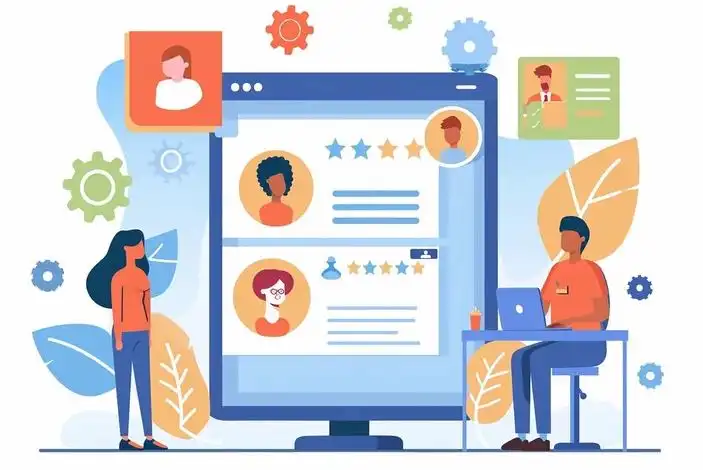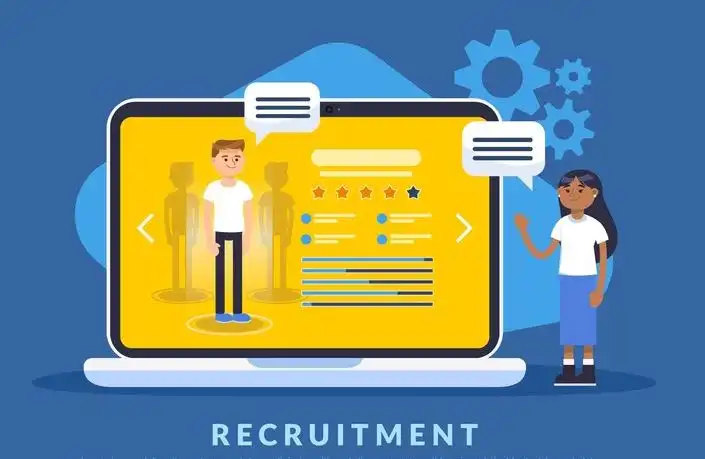Table of Content
Learn to Build Feature-rich HRM Solutions with this Guide
Working with a recruitment software to find and hire candidates has become important for companies. It is a software that simplifies their selection process, allowing them to pick the best talent that is available in the market. The in-house development of these software is therefore considered crucial for companies. Unfortunately, many of them do not know how to build a recruitment software due to lack of technical knowledge. They usually turn to specialized agencies to build a quality HRMS software that can manage all their screening, finalizing and onboarding processes efficiently.
Building a recruitment software isn’t that hard if you have got the basics covered. This software is undoubtedly different from other products, hence it needs a specialized strategy backed by market research to build a quality solution. Besides development planning, budget allocation is also important for this project. A lot of times, limited resources forces companies to swap their development plans. This is certainly a wrong approach, and it should be avoided by smartly setting aside a decent budget.
In this article, we will discuss in detail how to develop a recruitment software properly. It will be a good read for those who do not know much about HR software development, as how it is built and what type of resources are used in it. Let’s start from the basics understanding what is a recruitment software and why it is termed important for companies.
What is a Recruitment Software?

Recruitment software is a digital tool or platform designed to streamline the hiring process. It assists organizations in managing the entire recruitment lifecycle, from posting job openings to screening applications, scheduling interviews, and onboarding new hires. These systems are often equipped with features like applicant tracking, resume parsing, candidate relationship management, and analytics to help recruiters make data-driven decisions. By centralizing all recruitment activities in one platform, recruitment software reduces the administrative burden on HR teams and enhances their efficiency.
The software typically integrates with multiple job boards, social media platforms, and other HR systems, enabling recruiters to reach a broader pool of candidates and engage with them more effectively. It also offers tools for collaboration among hiring managers, allowing them to review candidates’ profiles, provide feedback, and make informed decisions together. Advanced recruitment software may incorporate AI to screen and rank candidates based on their qualifications, predict job fit, and even automate initial stages of communication.
Moreover, recruitment software enhances the candidate experience by providing a streamlined application process. It can also include features such as branded career pages, candidate assessment tests, and automated interview scheduling to further improve the experience for both candidates and recruiters. With its comprehensive suite of features, the role of HRMS in helping organizations attract top talent is huge. It reduces time-to-hire, and ultimately build a more skilled and effective workforce.
How Recruitment Software Eases Hiring Process

Recruitment software eases the hiring process by automating and centralizing various tasks. It simplifies job posting by allowing recruiters to create a single job description and post it across multiple job boards, career sites, and social media platforms simultaneously. This not only saves time but also ensures a wider reach, helping attract a larger pool of potential candidates. The software also automates repetitive tasks like resume screening, and ranking applicants based on their suitability, which accelerates the initial screening process and helps focus on high-potential candidates.
Another way recruitment software streamlines the hiring process is through enhanced collaboration and communication tools. It provides a centralized platform where recruiters, hiring managers, and other stakeholders can access candidate profiles and share feedback. Integrated calendars and automated interview scheduling features eliminate the back-and-forth of manual scheduling, ensuring a smoother interview process. Additionally, communication tools within the software can automate routine emails, keeping candidates engaged and informed without overwhelming the recruiting team.
Moreover, recruitment software offers robust analytics and reporting capabilities that provide valuable insights into the hiring process. These insights help HR teams identify bottlenecks, track key metrics such as time-to-hire and cost-per-hire, and make data-driven decisions to optimize their recruitment strategies. The software can also help enhance the candidate experience by providing a more streamlined and transparent application process, improving employer branding, and reducing the likelihood of candidate drop-off.
Step by Step Method to Build a Recruitment Software

To build a recruitment software, you need to follow a plan that is well aligned with the objectives of the project. Many beginners do not pay attention to this basic principle, and then face difficulties while developing the software. If you are also new to the dev field, make sure to follow these points properly.
Research & Evaluation
Conducting thorough market research is an essential step before embarking on the development of recruitment software. This research plays a critical role in ensuring that the final product is aligned with the needs and expectations of its intended users. Understanding user needs, industry trends, and competitive offerings allows developers to create a product that addresses specific gaps and provides real value. Without this foundational research, the software might fail to resonate with its audience, leading to lower adoption rates and wasted resources.
The initial phase of market research involves identifying and comprehensively understanding the target market. This process requires defining the primary users of the recruitment software, which could span a range of organizations from small businesses and startups to large enterprises with complex hiring processes. Each of these segments has distinct requirements and challenges; therefore, tailoring the software to address these specific needs is crucial.
To gather meaningful insights, it is vital to engage directly with potential users through various research methods. HR administrators and recruiters are key stakeholders whose input can reveal critical pain points in their current recruitment processes, such as inefficient candidate screening, time-consuming administrative tasks, or lack of integration with other HR tools. Understanding these challenges enables the agile development team to prioritize the most desired features, such as automated workflows, AI-driven candidate matching, or customizable dashboards.
Fuel innovation by leveraging bespoke software solutions. Get in touch with our team of experts to build cutting-edge software products.
Get a QuotePlanning & Budgeting
Planning and budgeting for a recruitment software project require a methodical approach that involves several structured steps to ensure its success. The process begins with a comprehensive project planning phase, which sets the foundation for the entire project. This stage is crucial because it establishes a clear vision and direction for the software development process. A detailed project plan helps in coordinating various teams, setting realistic timelines, and defining key milestones. Without a well-thought-out plan, the project risks going over budget, missing deadlines, or failing to deliver the desired outcomes.
The first step in comprehensive project planning is to define the scope and objectives of the retail management software. This involves clearly outlining what the software aims to achieve and the specific problems it will address within a retail environment. A well-defined scope prevents scope creep and ensures that the project remains focused on delivering the intended value. Part of this process involves identifying the core functionalities that the software must include to meet the needs of retailers effectively.
Once the scope and objectives are clearly defined, the next step is to break down the required functionalities into specific deliverables and tasks. Each functionality must be detailed into smaller components, outlining the necessary functional requirements. This breakdown allows for more accurate estimation of the resources, time, and budget needed for each component. Budgeting is a critical part of this process, as it involves allocating financial resources to various aspects of the project, such as software development, testing, deployment, and post-launch support.
Tech Stack Selection
After completing the planning and market research phases, the next step is to transition into the actual development phase of the project. This stage marks the beginning of turning ideas and plans into a functional software product. It is crucial to approach this phase with a well-structured methodology to ensure that the development process is efficient and organized. These methodologies provide a framework for managing tasks, timelines, and resources, and help ensure continuous collaboration among team members and stakeholders throughout the development cycle.
Before diving into coding and development tasks, one of the most critical decisions to make is the selection of the appropriate tech stack. The tech stack encompasses the set of technologies and programming languages, that will be used throughout the development process. Choosing the right tech stack is vital, as it directly impacts the software’s performance. The decision should be based on several factors, including the specific needs of the software, the expertise of the development team, and the future scalability requirements.
The tech stack selection process involves carefully evaluating and selecting technologies for both the front-end and back-end development of the software. For front-end development, the choice of technologies will focus on creating a responsive and user-friendly interface, which may include frameworks like React, Angular, or Vue.js, along with HTML, CSS, and JavaScript. For back-end development, the focus is on ensuring the software’s logic, database management, and server-side operations are robust and secure.
Project Development
After finalizing the entire technology stack, the next crucial step is to initiate the actual development process. This stage marks the beginning of turning ideas and designs into a working product. It involves setting up the development environment, aligning the team on coding standards, and breaking down tasks into manageable segments. Establishing a robust foundation at the outset is essential to ensure the development efforts are well-coordinated and that all team members clearly understand their roles and responsibilities.
The development phase is a comprehensive process that requires careful planning and efficient time management. It is essential to allocate sufficient time for each development activity, including writing clean and maintainable code, conducting unit tests, and integrating different components. Regular check-ins, progress reviews, and adjustments to the schedule are necessary to address potential bottlenecks as well. Effective communication and collaboration among team members are also critical to quickly resolving any issues that arise and ensuring the project stays aligned with its goals.
During this phase, the project team focuses on translating the detailed designs and technical specifications into a fully functional application. This involves writing the code, developing the backend and frontend components, and integrating various third-party services and APIs as needed. The team must carefully implement all features and functionalities as outlined in the project requirements, ensuring the application meets performance, security, and usability standards.
Test and Deployment
Prior to the official launch of your recruitment software, a team of QA engineers conducts a comprehensive and in-depth review of the system. This process is designed to evaluate the software against stringent criteria to ensure it adhere s to the highest standards. The focus is on several key areas, including usability, security, compatibility, and overall performance. Each of these aspects is meticulously examined to guarantee that the software is not only intuitive and user-friendly but also robust enough to withstand various scenarios and user environments.
The engineers employ a range of QA testing methodologies to simulate real-world usage and uncover any potential issues. This phase involves rigorous functional testing to confirm that all features work as intended, as well as usability testing to ensure the interface is accessible for end users. Additionally, security testing is conducted to identify and mitigate any vulnerabilities that could expose sensitive data. Compatibility tests further ensure that the software performs seamlessly across different devices, operating systems, and browsers, providing a consistent experience for all users.
This meticulous testing process is essential because it allows the team to identify and resolve any defects or shortcomings before the software reaches its users. By addressing these potential issues early, the team can prevent problems that could lead to a poor user experience, system malfunctions, or even security breaches. Ultimately, this careful preparation and attention to detail ensure that when the recruitment software is officially launched, it is a polished and reliable product that meets and exceeds user expectations, providing a smooth and effective solution for recruitment needs.
Frequently Asked Questions
| What is a recruitment software? Recruitment software is a digital tool designed to streamline and automate the hiring process by managing job postings, application tracking, and communication. It helps organizations efficiently find, evaluate, and hire qualified candidates while enhancing collaboration among hiring teams. |
| Why having a HRM solution is important for companies? Having a HRM solution is important for companies because it streamlines HR processes like payroll, recruitment, and performance management. It also provides valuable insights into workforce analytics, enabling better decision-making and fostering employee engagement. |
| What is the cost to build a recruitment software? The cost to build a HRM solution depends on various factors such as project features, timeline, third-party integrations and more others. On an average, this budget ranges from $20,000 to $45,000. |
Final Words
That sums up our entire blog in which we have discussed simple steps to build an advanced recruitment software. It is a known fact that every company needs an HRM solution to manage routine functions. Apart from assisting in hiring, a recruitment software also helps HR teams in managing the record of all the company employees. Some advanced HRM products also manage payroll operations, allowing businesses to completely automate the salary distribution process. This is what makes a recruitment software important for companies, hence it should be always developed internally keeping in view all the custom requirements of the HR department.
Empower your digital initiatives with BariTechSol, a premier custom software development company. Our skilled team tailors cutting-edge solutions to your unique needs. Elevate your tech experience and stay ahead in the digital realm. Partner with BaritechSol and code the success of your next big idea.


